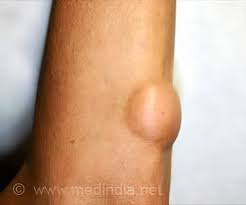 Most common soft tissue sarcoma in adults occurring predominantly in the lower extremities and the retroperitoneum.
Most common soft tissue sarcoma in adults occurring predominantly in the lower extremities and the retroperitoneum.
Myxoid liposarcoma accounts for 40-50% of all liposarcomas and is characterized by the(12:16)(q13-14; p11) translocation I greater than 90% of cases.
The commonest type well differentiated liposarcoma/dedifferentiated liposarcoma is characterized by amplification in chromosome 12q13-15 resulting in MDM2 and CDK4 overexpression.
Accounts for 15%-20% of all soft tissue sarcomas in adults.
Appear in adults in their 40s to 60s and are uncommon in children.
Commonly develop into very large tumors.
Usually presents as a painless slowly enlarging mass.
Approximately 3000 new cases diagnosed each year and an average annual incidence of 0.4 to 1.1 per 100,000 persons depending on sex and race.
Median survival is about 16 months.
Retroperitoneal liposarcoma is the most frequent subtype of retroperitoneal sarcoma accounting for 40% of lesions.
Well differentiated and dedifferentiated types are the most common types of retroperitoneal subtypes accounting for 90% of lesions.
Well differentiated type represents almost a third of liposarcomas and is the least aggressive subtype.
Well differentiated type consists of scattered lipoblasts and a single atypical nucleus surrounded by intracytoplasmic vacuoales.
Well differentiated liposarcoma has an indolent course with a tendency to recur rather than metastasize.
Well differentiated disease involves the retroperitoneum and proximal extremities primarily, but paratesticular and mediastinal sites may occur, and be more likely to recur and cause morbidity.
Well differentiated disease has overexpression of genes in 12q12-15 amplicon that includess cyclin-dependent kinase 4 (CDK4) and murine double minute-2 (MDM2), the regulator of p53.
Histologically divided into well differentiated, myxoid, round cell, dedifferentiated and allomorphic types.
Histology varies based on subtype and ranges from mature adipocytes and fibroblasts to undifferentiated cells with lipogenic differentiation.
Maligancy with fatty differentiation.
Subdivided into well differentiated , dedifferentiated , myxoid/round cell and pleomorphic histological subtypes.
Pleomorphic the rarest subtype and represents <5% of cases of liposarcomas.
Pleomorphic subtype is histologically and cytogentiacally distinct from liposracomas.
Pleomorphic subtype presents in adults in the sixth and seventh decades of life.
Pleomorphic subtype usually presents as a soft tissue mass which is painless.
Pleomorphic subtype can be a superficial lesion in 20% of cases and located within the subcutaneous fatty tissue and involve the dermis on occasion.
Pleomorphic subtype have pleomorphic lipoblasts on H and E staining, and large vacuoles may be present.
Pleomorphic subtype has a relatively aggressive prognosis with a 5 year survival ranging from 29-57%.
Pleomorphic subtype has the lung as the moct common metastatic site.
Pleomorphic subtype association with a lesion <10 cm, mitoses fewer than 10 per high powered fiels and predilection to the extemtities reflect a more favorable prognosis.
Pleomorphic subtype associated with adverse prognosis when tumor necsrosis and epitheloid areas are present.
Well differentiated type is usually indolent in growth pattern.
The myxoid variant is intermediate in its malignant behavior.
The myxoid, round cell and pleomorphic liposarcomas more commonly originate on the limbs.
Round cell and allomorphic variants are aggressive in their behavior, with high likelihood of metastases.
Dedifferentiated tumors have a significant mitotic rate, a high grade lesion that has a worse prognosis than well differentiated tumor with a great propensity to metastasize.
Dedifferentiated liposarcoma is the second most common liposarcoma and has an increased cellular component that transitions within a background of well differentiated liposarcoma.
Dedifferentiated disease tumors usually resent with well differentiated and dedifferentiated components.
Dedifferentiated subtype has amplification of CDK4 and MDM2 genes.
Dedifferentiated disease behave aggressive and has a 30% rate of distant disease, a 6 fold increased risk compared to well differentiated disease.
Dedifferentiated lesions require aggressive surgica approach and frequently undergo multiple surgeries.
Dedifferentiated lesions have a high local recurrence rate and pooe survival.
Dedifferentiated patients should be considered for a systemic approach but no regimens are effective.
Adjuvant radiation for dedifferentiated lesions should be considered for large, high-grade sarcomas of the extremity.
Less aggressive surgery can be applied to well differentiated tumors and neo adjuvant chemotherapy indicated for dedifferentiated tumors.
All types tend to recur locally and often require repeated surgical resection.
The quality of resection is an important factor for survival, especially for retroperitoneal liposarcoma.
After resection there is no role for adjuvant chemotherapy or radiation therapy in well differentiated disease.
For metastatic lesions trabectedin and eribulin can be considered.
Treatment of patients with advanced liposarcoma have a favorable progression free survival, with an occasional tumor response with palbociclib.
